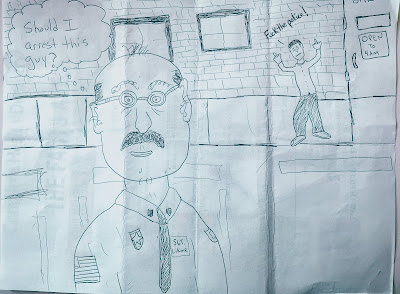Discussing Police Officers' Perceptions on Citizens' Attitudes
Introduction
Police
officers’ perceptions about citizen demeanor is essential in understanding the
use of discretion in police-citizen interactions. Many assumptions exist about this topic and
distort the reality of the events that cause police officers to perform
citations, arrests, or other mechanisms that they have the authority to
deliver. Specifically, many claims about
racial and ethnic biases and unnecessary interventions exist in these
interactions between police officers and civilians (Engel, Klahm, &
Tillyer, 2010; Engel, Tillyer, Klahm, & Frank, 2012). However, there is a large body of literature
that infers that police officers’ perceptions about citizen demeanor during
encounters is the main variable for the type of discretion that is used (Engel et al., 2010; Engel et al., 2012; Klinger, 1994;
Worden & Shepard, 1996).
Interestingly, the demeanor concept has many variations from police
officer-to-police officer and can even change again when citizens explain their
understanding of appropriate behavior while interacting with police officers (Engel
et al., 2010; Engel et al., 2012; Klinger, 1994; Worden & Shepard, 1996). Thus, the conundrum of what definition is
correct comes about. Nonetheless, the
perception of demeanor by police officers has more importance in social science
research because they are the party that is given the authority to make a
decision about what conduct is inappropriate and, in turn, requires a
particular administration of law enforcement.
Given this dilemma, this essay will summarize numerous academic writings
on police officers’ perceptions about citizen demeanor and the use of
discretion based on these perceptions to generate better understandings about
the content.
Summary
of Literature
Social
science research on this topic has repeatedly shown that there is a host of legal
and extra-legal factors that contribute to arrests and other applications of
law during encounters with police officers (Engel et al., 2010; Engel et al.,
2012; Klinger, 1994; Worden & Shepard, 1996). Claims of racial and ethnic biases, as well
as other alleged prejudices, has, for the most part, guided the purposes of
studying the decision-making processes in police work (Engel et al., 2010;
Engel et al., 2012). These allegations
have been traced back to the history of treatment toward minorities in the United
States in general and specifically by the hands of police departments, as well
as claims by civilians about police misconduct not pertaining to racial and
ethnic prejudices (Engel et al., 2010; Engel et al., 2012).
With
this being stated, there have been studies that show disproportionate arrests when
minorities interact with police officers, yet there are, again, many legal and
extra-legal factors that contribute to arresting an individual during these
police-citizen events that fail to be considered by laypeople (Engel et al.,
2010; Engel et al., 2012; Klinger, 1994; Worden & Shepard, 1996). First, the legal factors will be discussed in
their full breadth. That is, many
arrests that occur during police-related situations happen because of illegal
actions or previous illegal actions by citizens (Engel et al., 2010; Engel et
al., 2012; Klinger, 1994; Worden & Shepard, 1996). Contraband, warrants, disorderly conduct, and
any other unlawful activities by civilians are the major legal factors that
contribute to an arrest during encounters with police officers (Engel et al.,
2010; Engel et al., 2012; Klinger, 1994; Worden & Shepard, 1996). Research and arrest statistics validate this
but, in many cases, only present simplistic data of the illegalities that were
discovered by police officers and characteristics of the arrestees. So, even if there are disproportionate
numbers regarding minority arrests, the sheer fact that illegalities exist can circumvent
many claims about biases. Second, and
more important, extra-legal factors guide the use of arrest during encounters
with civilians more profusely (Engel et al., 2010; Engel et al., 2012; Klinger,
1994; Worden & Shepard, 1996).
Engel, Klahm, and Tillyer (2010) discussed how police officers’
perceptions about civilian conduct is the primary catalyst in determining
whether a person should be arrested during a traffic stop. More specifically, these scholars used data
from a prominent study in Cleveland, Ohio to merit their postulations (Engel et
al., 2010). Data from this study
confirmed that officers’ perceptions about disrespect being displayed toward
them resulted in a higher likelihood of arrest (Engel et al., 2010). Furthermore, interactions that entailed resentment,
anger, hostility, verbal and physical force and abuse resulted in police
officers making arrests during traffic stops more often than other forms of
disrespect (Engel et al., 2010). The
findings also indicated that race and ethnicity did not have a significant
influence on drivers’ arrest when other legal and extra-legal factors were
controlled for (Engel et al., 2010, p. 298).
In
a unique contrasting notion, Klinger (1994) questioned the operationalization of
citizen demeanor in previous studies by using three key factors that he felt had
been overlooked. First, he pointed to
how demeanor has been improperly defined as criminal behaviors in many studies
in general, which in turn means that previous studies failed to properly define
and separate citizen demeanor and illegal behavior (Klinger, 1994). Second, Klinger (1994) posited how many
previous studies failed to control for criminal behaviors during interactions
with police officers and, as he infers, that citizen demeanor was not properly
defined or controlled for as well.
Lastly, Klinger (1994) stated that measures of criminal behavior have
been so imprecise in previous studies that it has created a serious flaw in the
specific research subject. This notion
about misguided research by Klinger (1994) caused many social scientists to
reexamine their measures on police officers’ decisions to arrest (Engel et al.,
2012; Worden & Shepard, 1996). In
his words, “…the manner in which previous observational police research
controlled for crime may have consequences beyond the demeanor issue. It raises the prospect that all reports of
independent extralegal effects may misrepresent the nature of the relationship
between the particular factor and arrest” (Klinger, 1994, p. 491). Given the desired accuracy in academic
research, it is proper to pose this inquiry when examining police officers’
perceptions about behaviors that are deemed worthy of arrest.
Because
of this, researchers began to reexamine studies and be more precise during
their analyses. Worden and Shepard
(1996) did exactly this and also criticized Klinger (1994) for his dissent
toward previous research agendas on demeanor and police use of discretion. They suggested that the operationalization
was not as problematic as Klinger (1994) presented because of the variations in
analyses on demeanor and other variables in this subject (Worden & Shepard,
1996). Basically, the idea that a
general claim about particularities associated with measurements on demeanor
during police-citizen encounters was not valid according to Worden and Shepard
(1996). They also confirmed the idea
that controls for demeanor were done according to the specifics in many
examinations on the subject (Worden & Shepard, 1996). Thus, discrediting Klinger’s (1994) scrutiny
and putting faith back into the previous research on the topic of citizen
demeanor and arrests by police officers.
Since
the validity of demeanor measurement had been questioned, more detailed
research methods were undertaken by social scientist examining the
subject. Engel, Tillyer, Klahm, and
Frank (2012) also recognized the issues presented by Klinger (1994) and decided
to embark on a study that attempted to resolve the quandaries about measuring
demeanor. Traffic stops and civilian
demeanor during these encounters were again measured to comprehend how perceptions
of demeanor by police officers influenced the administrations of justice (Engel
et al., 2012). Even though these authors
went to great lengths to define various types of demeanor and, in turn,
performed advanced research methods to determine correlations, they still
discussed the difficulties in properly defining it and went on to say that it
is vital to attempt to understand the onset of specific demeanors by citizens
when interacting with police officers (Engel et al., 2012). This conclusion brought a new insight into
the studying of demeanor and police-citizen encounters. Elaborating more, researchers began to
measure the reasons why citizen demeanors came about, as well as the
perceptions of the demeanors by police officers with specific situations in
mind.
Conclusion
In
sum, research on demeanor during police-citizen encounters has produced mixed
results (Engel et al., 2010; Engel et al., 2012; Klinger, 1994; Worden &
Shepard, 1996). Some scholars have
inferred that the majority of measurements on demeanor are appropriate due to
the specifics of the studied being performed, while others have posited that
more in-depth explorations about the reasons for the onset of demeanors should
take place (Engel et al., 2010; Engel et al., 2012; Klinger, 1994; Worden &
Shepard, 1996). Although the
discrepancies are evident, the body of research about police officers’
perceptions on citizen demeanor suggests that behavior that is viewed as
disrespectful or inappropriate has a higher likelihood to result in an arrest (Engel
et al., 2010; Engel et al., 2012; Klinger, 1994; Worden & Shepard, 1996).
References
Engel, R. S.,
Klahm, C. F., & Tillyer, R.
(2010). Citizens’ demeanor, race,
and traffic stops. In
S. K. Rice & M. D. White (Eds.),
Race, ethnicity, and policing: New and essential
readings
(pp. 287-308). New York, NY: New York University Press.
Engel, R. S.,
Klahm, C. F., Tillyer, R., & Frank, J.
(2012). From the officer’s perspective:
A
multilevel examination of citizens’ demeanor during traffic stops. Justice
Quarterly,
29(5), 650-683.
Klinger, D.
A. (1994). Demeanor or crime? Why "hostile" citizens are more likely
to be
arrested. Criminology,
32(3), 475-493.
Worden, R. E.,
& Shepard, R. L. (1996). Demeanor, crime, and police behavior: A
reexamination of the police services
study data. Criminology, 34(1), 83-105.
 |
| Photo Credit: Benjamin Bolton |


Comments
Post a Comment